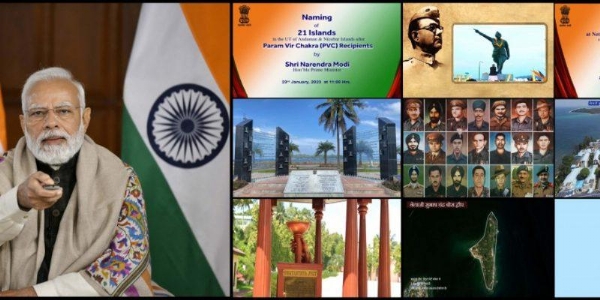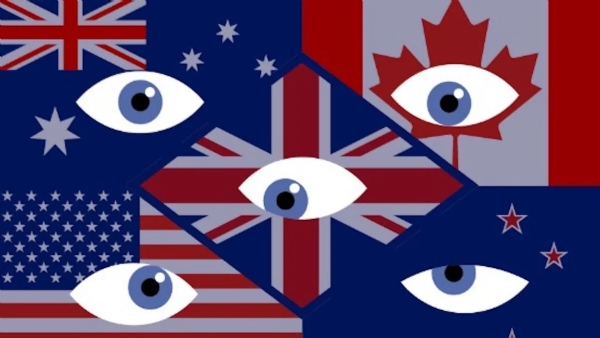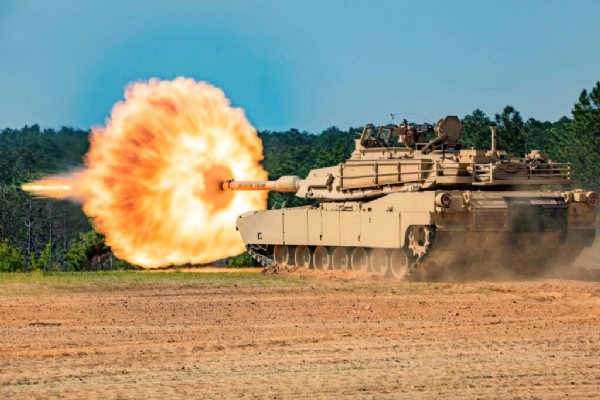#SecurityScan 28: Wargaming Chinese invasion of Taiwan, China's decline in population and more
28 Jan 2023 18:09:36
This article is a summary of important events that have taken place in the last one week affecting India's national security.

NEWS IN BRIEF
1. Republic Day Parade 2023: Indian Army showcases Made in Indian weapons
"The weapons displayed included the K-9 Vajra howitzers, MBT Arjun, Nag anti-tank guided missiles, BrahMos supersonic cruise missiles, Akash air defence missiles, and the Quick Reaction Fighting Vehicles. India Army showcased 'Made in India' Weapons systems during the Republic day parade on January 26. The Republic Day parade is a very big event for the entire nation which is watched across the globe."
India celebrated its 74th Republic day parade and this year's Republic Day Parade, Indian Army would showcase only Made in India Weapons systems. Akash Missile system is a newly inducted weapon system which is one of the most advanced weapon systems currently.
In the Republic Day Parade held at Kartavya Path in Delhi, personnel from the Army, Air Force, Navy, and Paramilitary forces participated. Twenty-three tableaux from 17 states and various departments of the government took part in.
45 aircraft including 9 Rafale jets and four helicopters were included in the fly-past at the celebrations. The IL-38 plane of the Indian Air Force took part in the Republic Day parade for the first and perhaps the last time. Formations of the flag, Rudra, eagle, Tiranga, Garuda, Bhima, Amrit, and Vijay among others were made in the fly past.
2. India’s alarm - as China and Bhutan move closer to resolving border
China’s talks with Bhutan prompted India to send its foreign secretary over for meetings with the kingdom’s leaders.Bhutan attempts to settle border dispute with China should not hurt India’s strategic interests.
3. India’s electric vehicle market glides into future
The Indian government has offered producers incentives to help with emerging technologies which are working very well.
4. Apple targeting manufacturing 25% of all of its iPhones in India
Last year, Apple began assembling its flagship iPhone 14 in India. It was the first time Apple produced its latest model in India so close to its launch.Apple has been looking to diversify production away from China, where it currently makes the bulk of its iPhones, after a Covid outbreak at its main assembly plant exposed fragilities in its supply chain.
5. Egypt shows keen interest in procuring Tejas jets, other platforms from India
The Egyptian side conveyed its keenness on acquiring the Indian platforms during delegation-level talks between Prime Minister Narendra Modi and Egypt's President Abdel Fattah El-Sisi. The 68-year-old influential Arab leader was on a three-day visit. He graced the Republic Day celebrations as the chief guest.
6. Naming of Andaman Islands After PVC Winners
The Union Government deserves appreciation for naming 21 islands of the Andamans after Param Vir Chakra awardees. Befittingly, Prime Minister Narendra Modi made the announcement on the occasion of the 126th birth anniversary of Netaji Subhas Chandra Bose, the legendary freedom fighter who had hoisted the Tricolour in the archipelago on December 30, 1943. The PM also unveiled the model of a Bose memorial to be set up on Netaji Subhas Chandra Bose Island, which was previously known as Ross Island. It was on December 30, 2018, that the PM had announced the renaming of Ross Island, Neil Island (Shaheed Dweep) and Havelock Island (Swaraj Dweep) to honor Bose’s memory and acknowledge the Andamans’ contribution to the freedom struggle.

The 21 islands have been named after valiant soldiers such as Major Somnath Sharma (the first Param Vir Chakra awardee), Major Shaitan Singh, Lance Naik Albert Ekka, Major (later Colonel) Hoshiar Singh, 2nd Lt Arun Khetarpal, Flying Officer Nirmaljit Singh Sekhon, Captain Vikram Batra and Grenadier (later Subedar Major and Hony Captain) Yogendra Singh Yadav.
Most of these heroes made the supreme sacrifice during various wars that India has fought since Independence. This special homage is also a glowing tribute to the armed forces’ all-important role in defending the nation’s borders over the decades.
The government’s laudable gesture has turned the spotlight on the Andamans, that are best known not only for their wonderful beaches but also for the Cellular Jail, where India’s freedom fighters were incarcerated by British rulers. Government is working on making the islands self-reliant. This is a huge challenge as the archipelago needs better Internet connectivity and a robust road network. The development of infrastructure is necessitated by the Andamans’ strategic importance in view of their proximity to the Indo-Pacific region.
Established in 2001, the Andaman and Nicobar Command (ANC) is India’s sole integrated theatre command. Its operational preparedness is vital for national security amid the military threat posed by China. Bolstering the ANC is also a prerequisite for carrying out much-delayed theatrisation of the defence forces.
7. Data Security -Beijing uses the popular app to steal data, censor, propagandize and spread disinformation
WeChat is the most popular communications platform in the world for Chinese speakers. It’s also a preferred vehicle for China’s Communist Party to steal data, censor, propagandize and spread disinformation in the world, where the app has an average of 19 million daily users. Many countries have banned the use of TikTok on government devices recently, and the USA is reportedly seeking to go further by, for instance, limiting access to user data to mitigate the app’s dangers.
Given the need to address threats emanating from a Chinese app, why is WeChat being ignored?
Japan’s military build-up driven by fears over China’s rise and doubts about US alliance
Japan’s moves reflect decades-long efforts to be more self-reliant amid growing concerns over China’s rise and the reliability of the US as an ally.
Military stronger Japan is a good news for India for countering China.
8. Indonesia moving to keep China at bay in Natuna Sea
Indonesia is developing the East Natuna gas block to show China, it views the contested outer island region as a front porch and not a backyard.
9. Unmanned Systems in China’s Maritime ‘Gray Zone Operations’
While China’s autonomous underwater technologies are predominantly used for marine scientific research, they can also be used for military activities.
10. In its rivalry with the US, China leverages its advantages
While on the surface, the US has reduced imports from China, it continues to depend on it indirectly.China is a key supplier of electronic components to countries such as Vietnam and Mexico which export to the US, it dominates the production of rare earths and is part of the world’s largest free-trade bloc.
Getting out of Chinese clutches and reducing over dependence on China is a very serious concern for the USA just like it is for India.
11. Australia wants smart sea mines to put China in check
Canberra hopes improved mine warfare capability will deter China where its fanciful nuclear submarine plan has not.
12. Taiwan’s New Strategy to Keep China Away
Xi is already contending with many challenges at home, including dramatically slower economic growth (in part due to Beijing’s failed zero-COVID policies), an increasingly skeptical set of trading partners, and the biggest aging demographic crisis of any nation in history. And these leave aside the dire economic implications of a Chinese invasion of Taiwan: beyond the costs of a war, if China cannot get semiconductors from Taiwan, it would precipitate a collapse of the 70 percent of the world’s electronics that China produces and largely exports.
If the United States and other countries lose access to semiconductors, a global depression will result. An unsuccessful effort to seize Taiwan, on top of these other challenges, might mean the end of Xi’s tenure in power and, possibly, the end of the Chinese Communist Party as the ruling regime.
13. Wargaming a Chinese Invasion of Taiwan
CSIS think tank has developed a wargame for a Chinese amphibious invasion of Taiwan and ran it 24 times. In most scenarios, the United States/Taiwan/Japan defeated a conventional amphibious invasion by China and maintained an autonomous Taiwan. However, this defense came at high cost. The United States and its allies lost dozens of ships, hundreds of aircraft, and tens of thousands of service members. Taiwan saw its economy devastated.
Further, the high losses damaged the U.S. global position for many years. China also lost heavily, and failure to occupy Taiwan might destabilize Chinese Communist Party rule. Victory is therefore not enough. The United States needs to strengthen deterrence immediately says the think tank.
14. Intelligence Coperation-Japan Might Join the Five Eyes?
If Japanese policymakers decide that they wish to continue this integration at the intelligence-sharing level—and deepen it—then political will is required to make the necessary changes across Japan’s bureaucracy. These include creating the machinery for vetting and clearance, classification, and information-sharing procedures and then applying those across government, industry, and the Diet.

Broadly speaking, Japan needs to initiate internal changes and adopt similar cyber hygiene standards to those applied across the Five Eyes nations. This doesn’t mean Japan needs to build exact replicas, but rather Japan-specific approximations. Japan stands to gain by its accession to the Five Eyes—and the group would certainly gain by the inclusion of the world’s third-largest economy and third-largest military force in the Indo-Pacific region. It would also gain by Japan’s historic intelligence gathering on North Korea and China, while Japan would widen its understanding of other regions. What is required now is for the Five Eyes to quietly lay out that roadmap for accession so that Japan understands what is required.
15. How to Deepen US-Indian Naval Cooperation
While initial progress may be slow, increasing cooperation is the most effective way to surmount remaining trust barriers and create the bilateral relationship that both sides want but may be too afraid to ask for. A strong India-U.S. naval relationship’s reason for being need not be an explicit bogeyman — navies’ peacetime functions offer more than enough room for cooperation in areas of critical importance to both states.
But the skills built in peacetime will create the operational familiarity and flexibility needed to deal with future contingencies in the Indo-Pacific.
16. Defense Against Gray-Zone Aggression Needs a Whole-of-Society Approach
India will benefit by learning from other countries' pioneering activities. Given its large and absolutely crucial industry, India should launch gray-zone exercises for the private sector. It can study and adapt many European countries' national security curriculum. The Indian National Security Strategy should promise to do what a growing number of other countries are now doing: constantly keeping the public updated about prospective crises and how to prepare for them.
Thinking about crises is not enjoyable, but COVID and the Ukraine War have painfully demonstrated that thinking about events before they occur trumps having to collectively improvise while the crises are occurring.
The United States’ 2023 Agenda for Building a Stronger Relationship with India
India continues to lumber its way to world-class economic heft and has already become a defining military power in the Indo-Pacific. Its ability to weather global economic downwind, while effectively managing Chinese and Russian policy overtures speaks to its undeniable influence in framing the emerging policy ranks. U.S. policymakers should constantly assess the channels and priorities for engagement and make changes when improvements are required, says a US Think tank.
India's both soft and hard power is getting noticed at world level at regular intervals.
Applying Lessons of the Land and Naval War in Ukraine for a Potential War with China

The war in Ukraine is approaching a year in length with little indication of it ending in 2023. While the naval war in the Black Sea has ebbed and flowed, it has always been relegated to the background in favor of the land war. The Chinese military is certainly studying events there for lessons they can learn for a potential war with India.
Battlefield insights from Russia's invasion of Ukraine provide India with a framework to discourage adversaries like China from future aggression.
We also must learn from the naval war in the Black Sea by building a naval presence and fleet that will deter a future Chinese assault.
Analysis China’s decline in population
The last time China’s population saw a decline was in 1961, in the midst of a devastating four-year famine following Mao’s failed “Great Leap Forward” campaign. The latest decline in population, however, is no blip. The shrinking of the world’s most populous country by as much as 8,50,000 in 2022 marks a watershed moment with lasting consequences for China. Beijing announced on January 17 that births in China last year dropped by more than 10% to 9.56 million, with 10.41 million deaths. The 1.411 billion population will certainly be overtaken by India’s this year. China has spent the greater part of two decades trying — and failing — to get families to boost birth rates that have been declining since the government introduced a harsh “one-child policy” in 1980. The belated introduction in 2016 of a “two-child policy” to course correct was not met with enthusiasm. A government survey found that 70% would not have more children citing financial reasons.
China’s economy is already feeling the impact of demographic change. The 16-59 working age population (2022), was 875 million, a decline of around 75 million since 2010. Wages are rising, and labor-intensive jobs are moving out, predominantly to Southeast Asia. The above-60 population, meanwhile, had increased by 30 million to 280 million. The number of elderly will peak at 487 million by 2050 (35% of the population). China’s National Working Commission on Ageing estimates spending on health care for the elderly will take up 26% of the GDP by 2050.
Human Security-Need economic policy to cope with ageing population.
India is no longer young. It is turning 73. It is also on the way to becoming the most populous country in the world, leaving China behind. What is more, the fertility rate (the number of children that a woman is likely to bear during her reproductive years) has fallen below the replacement level of 2.2. This means the country will cease to reap the demographic dividend — a large number of youngsters will not be there to join the workforce to take care of an increasingly aging population that has stopped earning.
At this juncture, the country needs to execute a dramatic shift in the economic policy so that the youngsters joining the workforce henceforth can be more productive, contributing more to the economy than was the case earlier. This requires a shift in political perceptions, social policy and public spending.
--